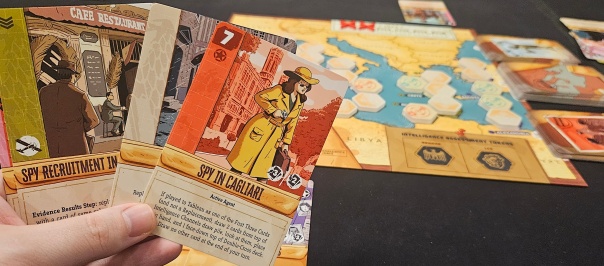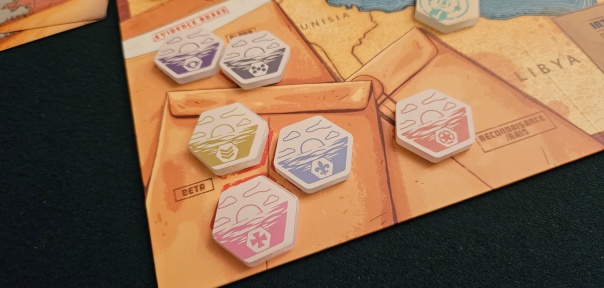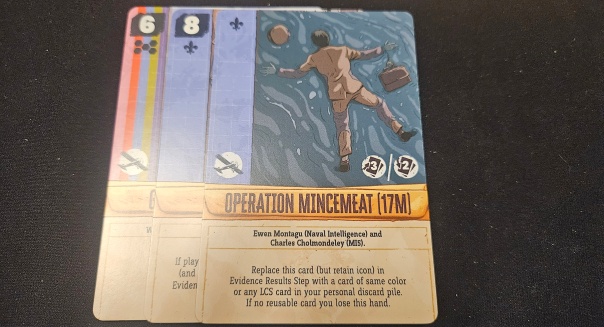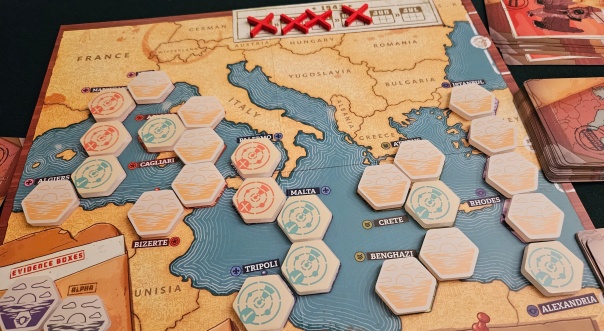Chuck Me in the Ocean
Posted by Dan Thurot
In 1943, to mask the upcoming invasion of Sicily, the Allies undertook a massive intelligence project. Called Operation Barclay, it included a number of smaller projects. The most famous of these, Operation Mincemeat, dumped a corpse with falsified information off the coast of Spain. Others included an inflatable landing force indicating a landing zone in the Balkans and increased resistance activity in Greece. The German High Command fell for the ruse, diverting ten divisions and the Italian navy eastward.
Now Maurice Suckling has turned this landmark deception into a board game. Operation Barclay is the latest in Salt & Pepper Games’ catalog of unusual wargames, following up on Resist!, The Hunt, and The Battle of Versailles. It’s the most abstract, most teachable, and least grounded of the bunch, for better and for worse.
Despite functioning with near uniformity, the feel of Operation Barclay differs for its two sides. As the Axis, this is a game of deduction. As presented by the board, there are five possible avenues for Allied invasion into Europe, each represented by five face-down tiles: southern France, Sardinia-Corsica, Sicily-Italy, or either of the Greek Peloponnese or Dodecanese. One of these is the Allies’ primary plan of attack; a secondary theater also exists, a fallback in case some change on the continent prevents the initial invasion. The Axis is determined to uncover both of these routes. The Allies arguably have the simpler task, at least in terms of the intelligence war: obfuscate, obfuscate, obfuscate.
In both cases, these warring powers either uncover tiles or keep them concealed by winning the best poker(ish) hands, built one card at a time until both sides have a full set of five cards. If it sounds simple, that’s because it is. There are a few particulars to keep in mind, but the gist always returns to the cards both players array on the table. It’s a refreshingly simple rubric to keep in mind. A full house beats a mixed straight beats two pairs, with five of a kind defeating all of them.
Of course, it’s the particulars that make Operation Barclay interesting. For example, your first three cards are played face-up. This is double-edged, trickling information to your opponent but triggering special abilities. You might, for example, utilize a spy in Algiers. This would let you look at the top two cards of the main draw pile and then draw one of them into your hand, tailoring your pool of cards and gaining a tidbit of knowledge. At the same time, you’ve now signaled to your opponent something about the hand you’re playing, its suit and rank.
This is important, because after those initial three deployments both sides place a wager on which side they suspect will win this month’s information war — as in, whose hand will be stronger after two more cards are added face-down to each side. While the stronger hand will earn a couple of tokens, this wager stands to earn the lion’s share of the month’s intel. This elevates those early plays from an information leakage to a poisoned well. If I start out strong — say, with cards that appear to be erecting a full house — perhaps my opponent will wager on my hand, only for me to reveal a pitiful two pairs. I may have yielded two tokens to the Axis, but I’ve deprived them of three more. Depending on the arrangement of those tokens, which are randomized at the start of each month, it’s even possible that I’ve prevented them from learning anything useful at all. I’m rolling all the way to Berlin, Jerry!
As systems go, this is a fitting, if abstract, way to represent the bluffs and double-bluffs that were the touchstones of deception warfare in WWII. You always have a sliver of the complete picture, just enough to give an impression of its outcome. But you can never be certain whether you’re piecing together its full composite or being led astray by a canny opponent.
There are other details to consider. In addition to a huge shared deck, both sides have access to their own deck of special abilities, far-ranging cards that highlight each power’s approach to intel and espionage. The deck for the LCS — the London Controlling Section — focuses on building comprehensive hands, with lots of multi-suited and -ranked cards. Operation Mincemeat exemplifies their approach, letting the Allied player swap it out for any card from their discard. It’s effectively a wildcard, letting the Allies double dip on anything they’ve played in the past. Their rivals, the Abwehr, struggle to build such powerful hands, but they have advantages of their own. In some cases, they can stomp all over the Allied hand, tossing out powerful cards for a random draw from the deck, or canceling certain Allied gambits outright. Even better, their cards boast lots of reconnaissance/raid icons, the third and final source of intel tokens each round. It’s a rare month that sees the Allies winning that category. The Axis has the home field advantage, after all.
Salt & Pepper’s recent catalog of new-age wargames has proven popular. They’re more approachable than your usual hist-sim fare, more accessible, not to mention handsomely illustrated. Operation Barclay is no exception. If anything, it leans into the curve. By speaking the universal language of poker(ish) hands, it presents few barriers. It’s easier to teach and play than any of the publisher’s previous offerings. I’d even go so far as to say that its abstract presentation is a perfect way to represent the notional realm of espionage. What better way to depict agencies piecing together garbled snippets of intel than by having players piece together garbled snippets of complete hands? What better verisimilitude is there for hovering in a bunker for the crackle of a radio to announce whether your waterlogged imposter has floated to shore than hovering over the draw deck for the right card to present itself? Operation Barclay’s sense of place and action arises thanks to its abstraction, not in spite of it.
At the same time, it doesn’t produce quite the same compulsivity as its predecessors. After only a few plays — and brisk plays at that — I feel I’ve seen everything it has to offer. There’s only so much to be done with the way the game presents its cards.
It’s possible I’m still riding high on The Battle of Versailles, which was my preferred historical game of last year. Or perhaps it’s because there’s only so much to be done with the format Suckling has settled on. While Operation Barclay is replete with thematic touches, it’s still easy to miss the landing beach for the wrought-iron hedgehogs scattered across the sand. More often than emphasizing the historical ramifications of its various events, everything comes back to building sets of cards. It’s just so easy to focus on suits and ranks over all else. So natural. Every so often the smoke clears. In those moments, Operation Barclay is a sparkling example of how history can be evoked in unexpected ways. Then the shroud descends and we’re thrust back into an unenthusing set-building game with some clever bluffing.
On the whole, Operation Barclay is a strong addition to Salt & Pepper’s catalog. When it comes to this sort of game, there’s a fine line to walk between abstraction, simplicity, and historical evocation. Although this title falls a little more to one side of the line than I would prefer, Suckling has gamified a tricky topic with a deft hand, producing tense moments and uncertain ruses redolent of the espionage activities of the Second World War. This is one bloated corpse I would gladly chuck into the ocean. In a mostly good way.
Unless I’m bluffing. Oh ho ho.
Operation Barclay is currently on Gamefound.
(If what I’m doing at Space-Biff! is valuable to you in some way, please consider dropping by my Patreon campaign or Ko-fi.)
A prototype copy was provided.
Posted on June 13, 2024, in Board Game and tagged Board Games, Operation Barclay, Salt & Pepper Games. Bookmark the permalink. 11 Comments.
Leave a comment Cancel reply
This site uses Akismet to reduce spam. Learn how your comment data is processed.





Sneakers! I need to watch that one again…
Ding ding ding!
It’s my comfort watch of choice.
Dammit! A mixed and nuanced review – I was really hoping this would come down hard on one side or another so I didn’t have to _make a decision_ about whether to back the campaign… Ah well, guess I’d better revisit and ruminate…
A delightful read as always.
Yeah, I’m useless at making decisions. You heard it here first!
Yup!
…not the decisions so much as the “mixed and nuanced review”
I recently played the same designer’s WW1 diplomatic posturing game Crisis 1914 and it seems similarly like a good translation of a theme into a very approachable board game, but also thin and a bit disappointing.
I want to try that one!
Dan your writing is a singular pleasure to read!! Just lovely. Bravo. Remind me of Patrick Rothfuss: sometimes I don’t even care what he is saying because the prose is just so lovely lol. A compliment I assure you!
Thanks for the kind words, Jason!
“… an unenthusing set-building game with some clever bluffing.” does rather summarize the opposite of where I was hoping this would land I’d better get a fuller grasp of this game before backing. Thank you for your insights.